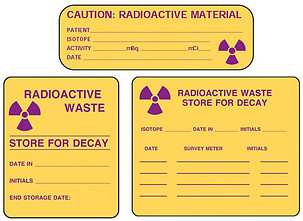Samarium-153
Production & Disposal
Production
Samarium-153 is a synthesized isotope, meaning it doesn't occur naturally and must be created in a lab. Usually, natural samarium is removed from mined bastnaesite and monazite sand using solvent extraction and ion exchange.

(Above) Nuclear Reactor.

(Below, Left to Right) Monazite and Bastnaesite.

The naturally occuring samarium, usually samarium-152 is bombarded with low-energy (thermal) neutrons in a nuclear reactor. The samarium target absorbs a neutron and excess energy is emitted as gamma rays. Increasing the neutron number by one results in samarium-153. Neutron irradiation resulting in a (n, gamma) reaction forms a radioisotope from a stable isotope of the same element. Radiochromatography is used to measure the purity of the samarium-153; which is generally in excess of 99.8% when generated this way. The radionuclide is then combined with a tetraphosphate chelator, ethylenediamine tetra-methylene phosphonic acid (EDTMP), to create the radiopharmaceutical lexidronam.



(Above, clockwise) Starting at top left: Polythene carboy, Bucket for solid waste, Label for storage.
Disposal
In a hospital environment, the disposal of radioactive waste involves two stages: collection and disposal. The radioactive waste should be contained separately from other kinds of waste within the department. Solid sources of radiation include syringes, needles, and containers used to hold the radio-pharmaceuticals; and are placed in foot-operated collection bins with disposable polythene linings. Liquid sources of radiation waste generally consist of leftover radiopharmaceutical solutions; and are placed on polythene carboys. Isotopes with different half-lives are kept in separate containers. Each package is labeled with the name of the isotope, level of activity, and date of monitoring; and kept secured until it's time for them to be disposed of. Methods of disposal for radioactive waste include: Dilute and Disperse, Delay and Decay, Concentrate and Contain, or Incineration. Given that it has a half-life of forty-six hours and decays to a stable europium isotope, samarium-153 is usually disposed of via Delay and Decay. Once its activity is around 0.1% of its original value, it will be disposed of as ordinary medical waste.
Dilute & disperse
Low activity solid articles may be disposed of as ordinary hospital waste as long as the activity is less than 1.35 microcuries. Within limits, liquid material with equal or lesser activity than previously mentioned may be poured into the sanitary sewage system, with adequate flushing with water following the disposal.
concentrate & contain
delay & decay
Medium activity waste and those with half-lives of less than a month may be stored in a properly ventilated room. The storage room must also be lined with lead shielding to prevent radiation leakage. The radioactive waste should be stored for a minimum period of about 10 half lives, until only 0.1% of the initial activity remains. At this point, the waste is considered low activity and can be disposed of as such.
incineration
This technique of radioactive waste disposal is sometimes used for radioactive materials with very high activity levels and for those with long half-lives (longer than a month). Their disposal by delay and decay method is impractical because of longer storage period, particularly if space availability is limited. The waste is placed in specialized and labeled containers and is buried in designated burial sites. This method is rarely used for medical waste as radionuclides with such high activity are not suitable for in vivo use.
Insoluble liquid waste, like from the liquid scintillation systems may be disposed via incineration. After incineration, the activity is concentrated in a smaller volume of ash for further disposal. Since incinerators used for radioactive waste disposal release part of the radioactivity into the atmosphere they operate under specific conditions and in segregated places. The collected ashes have to be separately disposed of as solid radioactive waste.